
ARVO 2024: Five-year prospective study comparing ocular stiffness parameters in patients with diabetes with and without retinopathy
Cynthia Roberts, PhD, sat down to discuss a 5-year prospective study to compare ocular stiffness parameters in, diabetes with retinopathy, diabetes without retinopathy, and normal subjects at this year's ARVO meeting held in Seattle, Washington, from May 5 to May 9.
Cynthia Roberts, PhD, sat down to discuss a 5-year prospective study to compare ocular stiffness parameters in, diabetes with retinopathy, diabetes without retinopathy, and normal subjects at this year's ARVO meeting held in Seattle, Washington, from May 5 to May 9.
Video Transcript
Editor's note - This transcript has been edited for clarity.
David Hutton:
I'm David Hutton of Ophthalmology Times. The Association for Research in Vision and Ophthalmology is holding its annual meeting in Seattle. At that meeting, Dr. Cynthia Roberts presented, "Increased scleral stiffness in diabetes with retinopathy than in diabetes without retinopathy." Thank you so much for joining us today. Tell us about your presentation.
Cynthia Roberts, PhD:
Thank you very much. I'm pretty excited about this presentation. It's the result of a 5-year prospective study to compare ocular stiffness parameters in, as you said, diabetes with retinopathy, diabetes without retinopathy, and normal subjects. The funding source was the National Institutes of Health, the Eye Institute, and we also received funding from Ohio Lions Eye Research Foundation that allowed us to add diabetic retinopathy, since NIH covered only diabetes without retinopathy and normal controls.
What we expected to find, and what was the premise of 1 aim of the original NIH study, was that the corneal response would be stiffer in diabetes than normal due to literature. And we did not find that, and, in fact, what we found, was that in diabetic retinopathy, the sclera exhibited a stiffer response than either diabetes without retinopathy or normal subjects, and they did not differ from each other. We were shocked to find this, and it took a lot of discussion for us to come up with what we think that scleral stiffness is a cumulative indicator of chronic hyperglycemia with the accumulation of advanced glycation end products, leading to non-enzymatic crosslinks in collagen fibrils and scleral stiffness. We don't think the air puff is sensitive enough to pick up the difference in stiffness of the cornea, but the sclera has a much larger surface area, and so, we can pick that up. We have a renewal of the grant to do a longitudinal follow-up and call these subjects back in after 5 years so that we can determine if scleral stiffness in diabetes is a risk factor for developing retinopathy. And we're in the process of of calling them back right now. And so, the goal of that grant is to develop a biomechanical risk model, and hopefully, I can tell you the result of that in about another 4 years.
Newsletter
Keep your retina practice on the forefront—subscribe for expert analysis and emerging trends in retinal disease management.








































